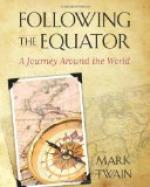My health had broken down in New York in May; it had remained in a doubtful but fairish condition during a succeeding period of 82 days; it broke again on the Pacific. It broke again in Sydney, but not until after I had had a good outing, and had also filled my lecture engagements. This latest break lost me the chance of seeing Queensland. In the circumstances, to go north toward hotter weather was not advisable.
So we moved south with a westward slant, 17 hours by rail to the capital of the colony of Victoria, Melbourne—that juvenile city of sixty years, and half a million inhabitants. On the map the distance looked small; but that is a trouble with all divisions of distance in such a vast country as Australia. The colony of Victoria itself looks small on the map—looks like a county, in fact—yet it is about as large as England, Scotland, and Wales combined. Or, to get another focus upon it, it is just 80 times as large as the state of Rhode Island, and one-third as large as the State of Texas.
Outside of Melbourne, Victoria seems to be owned by a handful of squatters, each with a Rhode Island for a sheep farm. That is the impression which one gathers from common talk, yet the wool industry of Victoria is by no means so great as that of New South Wales. The climate of Victoria is favorable to other great industries—among others, wheat-growing and the making of wine.
We took the train at Sydney at about four in the afternoon. It was American in one way, for we had a most rational sleeping car; also the car was clean and fine and new—nothing about it to suggest the rolling stock of the continent of Europe. But our baggage was weighed, and extra weight charged for. That was continental. Continental and troublesome. Any detail of railroading that is not troublesome cannot honorably be described as continental.
The tickets were round-trip ones—to Melbourne, and clear to Adelaide in South Australia, and then all the way back to Sydney. Twelve hundred more miles than we really expected to make; but then as the round trip wouldn’t cost much more than the single trip, it seemed well enough to buy as many miles as one could afford, even if one was not likely to need them. A human being has a natural desire to have more of a good thing than he needs.
Now comes a singular thing: the oddest thing, the strangest thing, the most baffling and unaccountable marvel that Australasia can show. At the frontier between New South Wales and Victoria our multitude of passengers were routed out of their snug beds by lantern-light in the morning in the biting-cold of a high altitude to change cars on a road that has no break in it from Sydney to Melbourne! Think of the paralysis of intellect that gave that idea birth; imagine the boulder it emerged from on some petrified legislator’s shoulders.
It is a narrow-gage road to the frontier, and a broader gauge thence to Melbourne. The two governments were the builders of the road and are the owners of it. One or two reasons are given for this curious state of things. One is, that it represents the jealousy existing between the colonies—the two most important colonies of Australasia. What the other one is, I have forgotten. But it is of no consequence. It could be but another effort to explain the inexplicable.




